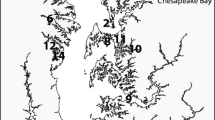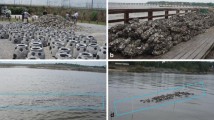Abstract
Shore protection and habitat enhancement along a residential island werethe main goals of this shoreline study. The physical and geological factorsnecessary to design shoreline stabilization structures capable of confidentlysupporting suitable and stable habitat enhancement/restoration substrate areemphasized since this area of study generally may be unfamiliar to wetlandresource managers. Erosion along the targeted shoreline is influenced by aunidirectional wave field from the south-southwest. Results of our analysesshowthat a headland control system comprised of headland breakwaters could be usedsuccessfully to stabilize the existing shoreline and provide resource managersflexibility in habitat restoration decisions. Headland breakwaters are designedto diffract wave energy so that shore planform equilibrium is attained and canbe sized and positioned to maximize the length of stabilized shoreline.Maximization of the new shoreline length provides increased subaerial,intertidal, and subaqueous environments for flexible habitat restorationalternatives. The final restoration design developed through this study willcreate approximately 69,000 m2 of new habitat includingstable beach, dune, tidal marsh, scrub shrub, and submersed aquatic vegetation.An additional 2,000 m2 of rock substrate habitat isprovided directly by the headland control structures.
Similar content being viewed by others
References
Boon J.D., Welch C.S., Chen H.S., Lukens R.J., Fang C.S. and Zeigler J.M. 1978. A Storm Surge Model Study. Storm Surge Height-Frequency Analysis and Model Prediction for Chesapeake Bay. Virginia Institute of Marine Science, College of William and Mary, Virginia, SRAMSOE No. 189, 149 pp. + app. I.
Bretschneider C.L. 1958. Revisions in wave forecasting: Deep and shallow water Sixth Conf. on Coastal Engineering, ASCE, Council on Wave Research.
Ebersole B.A., Cialone M.A. and Prater M.D. 1986. RCPWAVE –A Linear Wave Propagation Model for Engineering Use. CERC-86-4. 260 pp. U.S. Army Corps of Engineers Report.
Fenster M.S., Dolan R. and Elder J.F. 1993. A new method for predicting shoreline positions from historical data. J. Coast Res. 9: 147–171.
Hardaway C.S. Jr. and Gunn J.R. 1991. Headland breakwaters in Chesapeake Bay Coastal Zone' 91. Long Beach, CA, USA, pp. 1267–1281.
Hardaway C.S. Jr., Thomas G.R. and Li J.H. 1991. Chesapeake Bay Shoreline Studies: Headland Breakwaters and Pocket Beaches for Shoreline Erosion Control. Special Report in Applied Marine Science and Ocean Engineering Number 313. Virginia Institute of Marine Science, College of William & Mary, Gloucester Point, VA, UK, 153 pp.
Hardaway C.S. Jr., Gunn J.R. and Reynolds R.N. 1993. Breakwater design in the Chesapeake Bay: Dealing with the end effects. In: Hughes S.A. and Magoon O.T. (eds), Coast Engineering Considerations in Coastal Zone Management. American Society of Civil Engineers, New York, NY, USA, pp. 27–41.
Hardaway C.S. Jr. and Gunn J.R. 1998. Chesapeake Bay: design, installation, and early performance of four new headland breakwater composite systems 1998 National Conference on Beach Preservation Technology. St. Petersburg, FL, USA, pp. 1–18.
Hardaway C.S. Jr. and Gunn J.R. 1999. Chesapeake Bay: Design and early performance of three headland breakwater systems Proceedings of the Conference American Society of Civil Engineers: Coastal Sediments' 99. Hauppauge, Long Island, NY, USA, pp. 828–843.
Hardaway C.S. Jr. and Byrne R.J. 1999. Shoreline Management in Chesapeake Bay. Special Report in Applied Marine Science and Ocean Engineering Number 356. Virginia Institute of Marine Science, College of William & Mary, Gloucester Point, VA, UK, 54 pp.
Hobbs C.H., Peoples M.H., Anderson G.L., Patton M.A., Rosen P. and Athearn W.D. 1975. Shoreline Situation Report, Accomack County, Virginia. Special Report in Applied Marine Science and Ocean Engineering Number 80. Virginia Institute of Marine Science, College of William & Mary, Gloucester Point, VA, UK, 190 pp.
Hsu J.R.C., Silvester R. and Xia Y.M. 1989a. Generalities on static equilibrium bays. Coastal Engineering 12: 353–369.
Hsu J.R.C., Silvester R. and Xia Y.M. 1989b. Generalities on static equilibrium bays. J. Waterway, Port, Coastal, Ocean Engineering 115: 299–310.
Kiley K. 1982. Estimates of bottom water velocities associated with gale wind generated waves in the James River, Virginia. Virginia Institute of Marine Science, College of William & Mary, Gloucester Point, VA, UK.
NOAA 1989. East Coast of North and South America Including Greenland, Tide Tables 1989. U.S. Department of Commerce, National Oceanic and Atmospheric Administration, National Ocean Service.
Sauer J.R., Hines J.E., Gough G., Thomas I. and Peterjohn B.G. 1997. The North American Breeding Bird Survey Results and Analysis. Version 96.4. Patuxent Wildlife Research Center, Laurel, MD, USA.
Seaver D.M. and Austin H.M. 1995. Monitoring juvenile fishes in the surf-zone of Virginia, and development of a juvenile bluefish young-of-the-year index in Virginia: 1994 sampling season. Final Report to the Virginia Marine Resources Commission. 58 pp.
Sverdrup H.U. and Munk W.H. 1947. Wind, sea, and swell: Theory of relations for forecasting. U.S. Navy Hydrographic Office, Publ. No. 601.
U.S. Army Corps of Engineers 1977. Shore Protections Manual. U.S. Government Printing Office, Washington, D.C., USA.
U.S. Army Corps of Engineers 1984. Shore Protections Manual. U.S. Government Printing Office, Washington, D.C., USA.
Virginia Institute of Marine Science Wetlands Program 2001. Tidal Wetlands Impacts Data Home Page. Available: http://www.vim-s.edu/rmap/wetlands.
Wright L.S., Kim C.S., Hardaway C.S. Jr, Kimball S.M. and Green M.O. 1987. Shoreface and Beach Dynamics of the Coastal Region from Cape Henry to False Cape, Virginia. Virginia Institute of Marine Science, College of William & Mary, Technical Report, 116 pp.
Author information
Authors and Affiliations
Rights and permissions
About this article
Cite this article
Hardaway, C., Varnell, L.M., Milligan, D.A. et al. An integrated habitat enhancement approach to shoreline stabilization for a Chesapeake Bay island community. Wetlands Ecology and Management 10, 289–302 (2002). https://doi.org/10.1023/A:1020313020526
Issue Date:
DOI: https://doi.org/10.1023/A:1020313020526




